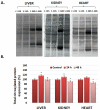In Vivo Evaluation of Innovative Gadolinium-Based Contrast Agents Designed for Bioimaging Applications
- PMID: 38674983
- PMCID: PMC11054998
- DOI: 10.3390/polym16081064
In Vivo Evaluation of Innovative Gadolinium-Based Contrast Agents Designed for Bioimaging Applications
Abstract
The aim of this study was the investigation of biochemical and histological changes induced in different tissues, as a result of the subcutaneous administration of Gd nanohydrogels (GdDOTA⸦CS-TPP/HA) in a CD-1 mouse strain. The nanohydrogels were obtained by encapsulating contrast agents (GdDOTA) in a biocompatible polymer matrix composed of chitosan (CS) and hyaluronic acid (HA) through the ionic gelation process. The effects of Gd nanohydrogels on the redox status were evaluated by measuring specific activities of the antioxidant enzymes catalase (CAT), glutathione peroxidase (GPx), and superoxide dismutase (SOD), as well as oxidative stress markers, such as reduced glutathione (GSH), malondialdehyde (MDA), advanced oxidation protein products (AOPP), and protein-reactive carbonyl groups (PRCG), in the liver, kidney, and heart tissues. The nitrosylated proteins expression were analyzed with Western Blot and the serum biochemical markers were measured with spectrophotometric methods. Also, a histological analysis of CD-1 mouse tissues was investigated. These results indicated that Gd nanohydrogels could potentially be an alternative to current MRI contrast agents thanks to their low toxicity in vivo.
Keywords: gadolinium-based contrast agents; magnetic resonance imaging; nanohydrogels.
Conflict of interest statement
The authors declare no conflict of interest.
Figures




Similar articles
-
Biocompatibility of Gd-Loaded Chitosan-Hyaluronic Acid Nanogels as Contrast Agents for Magnetic Resonance Cancer Imaging.Nanomaterials (Basel). 2018 Mar 28;8(4):201. doi: 10.3390/nano8040201. Nanomaterials (Basel). 2018. PMID: 29597306 Free PMC article.
-
Characterization of Gd loaded chitosan-TPP nanohydrogels by a multi-technique approach combining dynamic light scattering (DLS), asymetrical flow-field-flow-fractionation (AF4) and atomic force microscopy (AFM) and design of positive contrast agents for molecular resonance imaging (MRI).Nanotechnology. 2017 Feb 3;28(5):055705. doi: 10.1088/1361-6528/aa5188. Epub 2016 Dec 28. Nanotechnology. 2017. PMID: 28029111
-
In Vitro Studies Regarding the Safety of Chitosan and Hyaluronic Acid-Based Nanohydrogels Containing Contrast Agents for Magnetic Resonance Imaging.Int J Mol Sci. 2022 Mar 17;23(6):3258. doi: 10.3390/ijms23063258. Int J Mol Sci. 2022. PMID: 35328678 Free PMC article.
-
Influence of ferulic acid consumption in ameliorating the cadmium-induced liver and renal oxidative damage in rats.Environ Sci Pollut Res Int. 2019 Jul;26(20):20631-20653. doi: 10.1007/s11356-019-05420-7. Epub 2019 May 18. Environ Sci Pollut Res Int. 2019. PMID: 31104231
-
Relationship of oxidative stress in the resistance to imatinib in Tunisian patients with chronic myeloid leukemia: A retrospective study.J Clin Lab Anal. 2020 Feb;34(2):e23050. doi: 10.1002/jcla.23050. Epub 2019 Oct 16. J Clin Lab Anal. 2020. PMID: 31617242 Free PMC article.
References
-
- Carniato F., Tei L., Botta M., Ravera F., Fragai M., Parigi G., Luchinat C. 1H NMR Relaxometric Study of chitosan-Based Nanogels Containing Mono-and Bis-Hydrated Gd(III) Chelates:Clues for MRI Probes of Improved Sensitivity. ACS Appl. Bio Mater. 2020;3:9065–9072. doi: 10.1021/acsabm.0c01295. - DOI - PubMed
-
- Aime S., Botta M., Terreno E. Gd (III)-based contrast agents for MRI. Adv. Inorg. Chem. 2005;57:173–177.
Grants and funding
LinkOut - more resources
Full Text Sources
Miscellaneous

